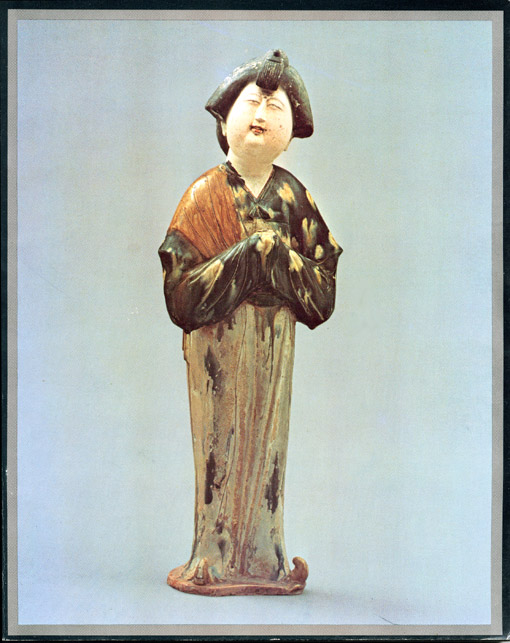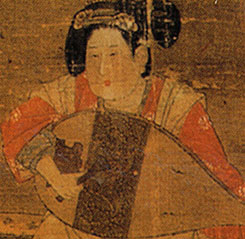 Modern
statue of Liu Bang
Modern
statue of Liu BangHistory 387—Early China
Ina Asim
Winter 2005
CRN 24270
UH 10-11.20
LIL 245
Office Hours: UH 11:00-12:00
Office: MCK 317
This course gives a survey of Chinese
History from the beginnings the end of the Tang Dynasty in the 10th century.
Based on written and archaeological sources the development of important Chinese
philosophical and religious concepts, as well as the formation of the state
and its imperial bureaucracy will be introduced. During this period the government
was managed by an aristocratic elite and a limited number of scholar-officials
selected by imperial exams. These officials pursued their tasks in government
and administration guided by principles that were based on Confucian philosophy.
The class of officials developped the blueprint of ethical values and aesthetic
expressions mirrored in the arts and in material culture that we have come to
identify as constituents of Chinese culture.
Course Requirements
1. Regular attendance and participation in class discussions. 20%
2. A short oral presentation on a topic discussed in the course. The presentation should not exceed 5 minutes. Topic options will be discussed during the first meeting. 20%
3. Two short quizzes. 10% each.
4. Midterm and final examinations. 20% each.
The following textbook is available for purchase at Black Sun Bookstore (on 2467 Hilyard Street, 484-3777, next to Sundance Supermarket and the restaurant 'Taste of India'):
Valerie Hansen, The Open Empire. A History of China to 1600. New York, London: W.W.Norton & Co. 2000.
Further readings are on reserve as books (articles
in journals and additional texts will be distributed as photocopies or made
available on electronic reserve).
Presentation pages
Bree- Mythological Rulers
Sarah- Filial Piety
Matt- Han Feizi
Christian- Liu Bang
Cara-The Role of Women
Michael - Inventions
Eric-
Private Industry of the Han
Brian-Terra
Cotta Warriors
Carlene- Tang music
Chris - Han Bureaucracy
Casey - Religious
Daoism
Jason - Philosophical
Daoism
Christie
- Guanyin and Maitreya
Lindsay - Basic Buddhist Teachings
Satomi - Buddha's
life
Megan-The Great Wall
Chris-Chinese Architecture
Justin-
Martial Arts
Adam - Bridges
Mitch - Yang guifei
Jesse-Horses
Josie - Empress Wu
David - An Lushan
Rebellion
Courtney-ChineseWarfare
Adam - Sima Qian
Brooke
- Empress Lü
Nova -Ban Zhao
Brian - Li Po
Vinca - Du Fu
Mike Payne -Eunuchs
Megan Dobson - Feng Shui
Peter- Ennin
and His Travels
Arian - Tang Tombs
Hist 387_1
Hist 387_2
Hist 387_3
Hist 387_4
Hist 387_5
Hist 387_6
Hist 387_7
Hist 387_8
Hist 387_9
Hist 387_10
Hist 387_11
Final: March 16, 8 am!
Please answer the following questions as a preparation
for the final exam. New questions have been added at the end of the previously
posted list!
1. What is China's most famous mythological hero, the Great Yu, best known for?
2. To which philosophical system is the concept of 'filial piety' linked?
3. Who was the teacher of the philosopher Han Feizi? Did this teacher have a
lasting influence on Han Feizi?
4. The terra cotta warriors were created in serial production. Did they all
look alike?
5. Liu Bang first became famous when he defeated the King of Chu, the aristocrat
Xiang Yu. Name one other reason why Liu Bang is remembered until this day.
 Modern
statue of Liu Bang
Modern
statue of Liu Bang
6. Despite the political success of the Han, there were
some measures inhibiting economic development. Name two of them.
7. The Han initially divided half of its commandaries into "kingdoms"
governed by appointed rulers. Did this political strategy weaken the centralized
government essentially?
8. Why did the Chinese revere horses?
Where did they get their horses from?
 Tang Emperor Taizong's horse
Tang Emperor Taizong's horse
When were the horse statues shown below produced?
(If they are genuine :-)

9. Name two reasons why Empress Wu Zetian was remembered
positively in history despite her political intrigues.

Tomb of Emperor Gaozong and Empress Wu Zetian
10. Who was Yang Guifei?
 Yang Guifei mounting
her horse
Yang Guifei mounting
her horse
11. A large rebellion brought the Golden Age of the Tang Dynasty to an end.
Which military leader was responsible for the rebellion?
12. Name some of the freedoms women enjoyed in the Tang dynasty that were lost
later in history.
13. Compare the images of the two ladies below. Which change in fashion do they
represent?


14. Which instrument is shown in the images below?


15. Buddha, born as Prince Siddharta into a royal clan
in Nepal, taught compassion and a moral code which consisted of five important
rules:
A follower of Buddhism should
- Not kill
- Not steal
- Not overindulge in any way including sexuality
- Not speak the untruth
- Not loose mindfulness (by intoxication)
Name reasons why Buddhism was accepted in Chinese society.
16. Which of the following images shows a Buddha, a bodhisatva.



17. Confucianism was revived in the 10th century by three famous philosophers.
The teaching again gained prominence because a canon of philosophical treatises
was created that had to be studied by every scholar and became the intellectual
basis of the ruling elite. Which essential principle of Confucianism was stressed
by these Neo-Confucian thinkers and is shared by the other two important thought
systems of China, Daoism and Buddhism?
18. Dao is translated as "the Way" and is roughly defined as the
source of life that all things depend on. Which philosophical systems
use the term?
19. What does the philosphical principle of 'Non-action' mean in Daoist thinking?
20. Daoists seek 'immortality'. Name ways pursued to gain immortality.
21. Which philosophy celebrates poems,
artists, and monks who follow an eccentric lifestyle?
22. Name two important inventions made in Early China.
23. The Chinese built different kinds of bridges at
a very early age. Describe the bridges shown below.


 Bridge at Puqing
Bridge at Puqing
24 . The image below shows the Great Wall. Who started to build the wall and
for what purpose?
Which materials were used to build this monument?

25. Name two characteristics of ancient Chinese architecture. Use the images
below for support.



26. The beginnings of martial arts are dated back to
the Warring States period, when a class of fighters protected the nobility as
escorts. A variety of schools developed from this class, one of them the Shaolin
school, where a famous Buddhist monk from India taught for nine years. Name
the martial arts teacher of the Shaolin monks. He lived from 448 to 527 C.E.

 Shaolin fighters
Shaolin fighters
27. What is the most important teaching we can learn from the Chinese classic
The Art of War?
NEW QUESTIONS:
28. Who was Monk Ennin? Why did he become famous?
29. Ban Zhao completed the History of the Han Dynasty that her father Ban Biao
and her brother Ban Gu had begun. Which other book did she write? What was her
profession when she was called back to court after having been exiled?
30. Which role did eunuchs play at court?
31. Feng Shui means 'wind and water'. It is a system that helps to position
a grave or a house in favorable conditions provided by the natural landscape.
Can the landscape be altered to improve the location? How is fengshui linked
to superstition?
32. Please compare the following two poems. Which was most likely written by
the poet Du Fu, which by Li Bo? Please explain your choice briefly.
Late Bloomer at the Front of My Garden
A 'Queen Mother of the West'- peach tree is planted in my yard,
After threethousand warm springs,
it finally had a flower.
This strain and delay producing a fruit,
was laughed at all around,
But when I climbed up to pick it, aah, aah, I sighed aloud.
Spring View
The nation is ruined, but mountains and rivers remain.
This spring the city is deep in weeds and brush.
Touched by the times even flowers weep tears.
Fearing leaving the birds tangled hearts.
Watch tower fires have been burning for three months
To get a note from home would cost tenthousand gold.
Scratching my white hair thinner
Seething hopes all in a trembling hairpin.
For your information:
An excellent webpage concerning Study Skills can be found under
http://www.iss.stthomas.edu/studyguides
There are many study skill guides on the internet; the advantage of this one is that most of its features are multilingual. Languages used for the webpage include English, French, German, Chinese, Bahasa Indonesia, Arabic and many other languages.
Course Outline
Week 1
1/4 U 1. Introduction; chronological survey of political and military events
1/6 H 2. The first written records of Chinese history
(Hansen, 17-41)
_____________________________________________________________________
Week 2
1/11 U 3. The Zhou conquest of the Shang
(Hansen, 43-53)
1/13 H 4. The 'Age of Philosophy' in a time of war
(Hansen, 54-67)
_____________________________________________________________________
Week 3
1/18 U 5. Confucius and subsequent teachers
(Hansen, 67-95)
1/20 H 6.
(Hansen, 97-112)
_____________________________________________________________________
Week 4
1/25 U 7. Film on Qin Shihuang
1/27 H 8. Power struggles and economic problems in the Han
(Hansen, 112-135)
Presenters 1-5
_____________________________________________________________________
Week 5
2/1 U 9. MIDTERM
2/3 H 10. The restoration of the Later Han
(Hansen, 136-143)
Presenters 6-10
______________________________________________________________________
Week 6
2/8 U 11. Philosophical Daoism and the evolution of a Daoist church
(Hansen, 142-149)
Presenters 11-15
2/10 H 12. The transmission of Buddhism
(Hansen, 153-175)
Presenters 16-20
______________________________________________________________________
Week 7
2/15 U 13. Patrons of Buddhism: The rulers of the Northern Wei Dynasty
(Hansen, 175-189)
Presenters 21-25
2/17 H 14. Unification under the Sui-Dynasty
(Hansen, 191-202)
Presenters 26-30
______________________________________________________________________
Week 8
2/22 U 15. The Golden Age of the Tang Dynasty
(Hansen, 203-219)
Presenters 31-35
2/24 H 16. Film on the Tang Dynasty
______________________________________________________________________
Week 9
3/1 U 17. The An Lushan-Rebelion and its consequences
(Hansen, 221-245)
Presenters 36-40
3/3 H 18. The significance of the silkroad and the finds of Dunhuang
(Hansen, 245-258)
______________________________________________________________________
Week 10
3/8 U 19. The Tang-Song transition
(Hansen, 261-275)
3/10 H 20. Review session
______________________________________________________________________
Week 11
3/16 W 8.00 am FINAL